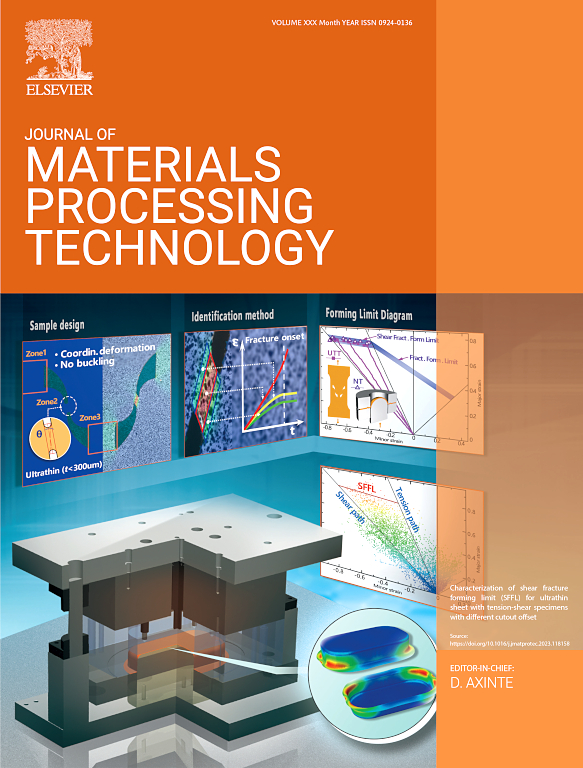Rolling in-situ generation of metallurgical and mechanical bonding improves mechanical properties and synergistic deformation ability of semi-solid cast-rolled aluminum/steel composite plate
IF 6.7
2区 材料科学
Q1 ENGINEERING, INDUSTRIAL
Journal of Materials Processing Technology
Pub Date : 2025-03-20
DOI:10.1016/j.jmatprotec.2025.118821
引用次数: 0
Abstract
A nowel processing technology was developed to solve the problem of low bonding strength caused by intermetallic compounds (IMCs) of aluminum/steel composites. This approach utilizes semi-solid cast-rolling to fabricate composite plates with a thin metallurgical bonding layer, followed by in situ formation of metallurgical and mechanical bonding through rolling, thereby enhancing the mechanical properties of aluminum/steel composite plate. Results demonstrated that a primary metallurgical bonding layer of approximately 6 μm formed after semi-solid cast-rolling, with a shear strength of only 38.8 MPa, while a reduction rate of 20 % increased the mechanical bonding strength to 46.0 MPa. The optimal mean mechanical bonding strength of 59.5 MPa was achieved at a reduction rate of 30 % with five rolling passes, exceeding the lower limit of the critical reduction rate required for aluminum/steel composite plate preparation by traditional rolling. With an increasing reduction rate, steel deformation, crack gaps (equivalent deformation) in IMCs, and coordinated deformation in composite plates also increase, promoting the formation of secondary bonding with alternating soft and hard phases. At a 50 % reduction rate, the shear strength of the aluminum/steel composite plate reaches 119.0 MPa, representing a 206.7 % increase compared to semi-solid cast-rolling. The ultimate tensile strength (UTS) of the composite plates with a 50 % reduction rate exceeded that predicted by the rule of mixtures by 17.1 MPa, while uniform elongation (UE) and fracture elongation (FE) increased by 35.3 % and 120.0 %, respectively, compared to high-elongation steel. The current study presents a novel investigation into the influence of bonding modes on the shear strength of aluminum/steel composite plates, offering new perspectives for designing and manufacturing dissimilar alloy interfaces.
原位轧制产生的冶金和机械结合改善了半固态铸轧铝/钢复合板的力学性能和协同变形能力
针对铝/钢复合材料中金属间化合物(IMCs)结合强度低的问题,开发了一种新的加工工艺。该方法采用半固态铸轧法制备具有薄冶金结合层的复合板,再通过轧制原位形成冶金结合和机械结合,从而提高铝/钢复合板的力学性能。结果表明:半固态铸轧后形成了一层厚度约为6 μm的初级冶金结合层,剪切强度仅为38.8 MPa,而降低率为20% %时,机械结合强度可提高到46.0 MPa;在5道次压下率为30 %的情况下,平均机械结合强度达到59.5 MPa,超过了传统轧制制备铝/钢复合板所需的临界压下率下限。随着压下速率的增加,钢的变形、内嵌件的裂纹间隙(等效变形)以及复合材料板的协调变形也随之增加,促进了软、硬相交替的二次结合的形成。在50% %的压减率下,铝/钢复合板的抗剪强度达到119.0 MPa,比半固态铸轧提高了206.7 %。与高伸长率钢相比,还原率为50% %的复合材料板的极限抗拉强度(UTS)比混合规律预测值高出17.1 MPa,均匀伸长率(UE)和断裂伸长率(FE)分别提高了35.3% %和120.0 %。本研究对不同结合方式对铝/钢复合板抗剪强度的影响进行了新的研究,为不同合金界面的设计和制造提供了新的视角。
本文章由计算机程序翻译,如有差异,请以英文原文为准。
求助全文
约1分钟内获得全文
求助全文
来源期刊

Journal of Materials Processing Technology
工程技术-材料科学:综合
CiteScore
12.60
自引率
4.80%
发文量
403
审稿时长
29 days
期刊介绍:
The Journal of Materials Processing Technology covers the processing techniques used in manufacturing components from metals and other materials. The journal aims to publish full research papers of original, significant and rigorous work and so to contribute to increased production efficiency and improved component performance.
Areas of interest to the journal include:
• Casting, forming and machining
• Additive processing and joining technologies
• The evolution of material properties under the specific conditions met in manufacturing processes
• Surface engineering when it relates specifically to a manufacturing process
• Design and behavior of equipment and tools.
 求助内容:
求助内容: 应助结果提醒方式:
应助结果提醒方式:


